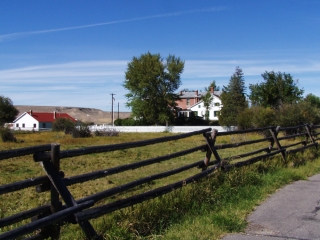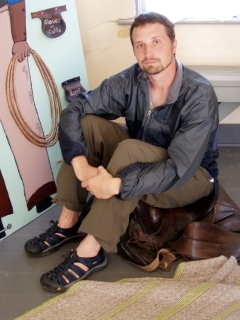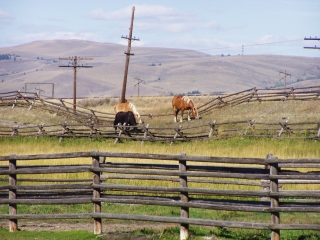NPS Website; Local Website
 WHAT IS IT?
WHAT IS IT?Once one of the largest open range ranches in the United States, the Grant-Kohrs Ranch NHS commemorates the cattle ranching industry of the 19th Century.
BEAUTY (5/10)
The Site is nestled in a beautiful Rocky Mountain valley, the Flint Creek Range to the west and the Continental Divide to the east. The Ranch’s setting is very peaceful but the tourist never loses sight of its ruggedness. The Victorian Ranch House is charming and quirky. Conrad Kohrs had a sly sense of humor while his wife, Augusta, amiably tried to give her frontier home a comfortable old world touch.
HISTORICAL INTEREST (3/10)
Cattle ranching began in the Deer Lodge Valley in the 1850s when Johnny Grant, a Canadian fur trader, settled in the area and realized that pioneers on the Oregon Trail were more than willing to trade two tired cows for one strong and healthy one to make it across the mountainous terrain ahead. It didn’t take him long to amass over 2000 cattle.
Grant moved back to the more civilized Canada a few years later, leaving the ranch and all of its belongings for sale. In 1866 Conrad Kohrs, a German butcher, purchased the property. Two years later, he brought his young wife Augusta and half-brother John Bielenberg to the Montana ranch. Together, they grew the ranch into an empire, grazing cattle across four states.
Because Kohrs and Bielenberg diversified their stock and their business interests, the “killing winter” of 1886-87 did not devastate their ranch, as it did most other ranchers, Teddy Roosevelt included. The brothers survived harsh weather and extreme market fluctuations and were able to capitalize on other ranchers’ inability to do so.
When Kohrs’ only son passed away, he began reducing his holdings of the ranch, selling all but 1,000 acres and the ranch house. A grandson purchased the remaining pieces of the original Kohrs’ ranch, managed it on his own for a decade. Once Augusta passed away, he preserved the ranch house and most of the ranch’s working documents and offered it to the federal government. It became a national historical site in 1972.
The Grant-Kohrs Ranch represents the height of open range ranching in the United States. This era where rugged cowboys drove cattle across the land, unfettered by barbed wire and property lines, is a part of the portrait of the American West.
 CROWDS (8/10)
CROWDS (8/10)We arrived for the last tour of the day, expecting to be all alone. Instead, we were accompanied by four tourists from Cologne, Germany, a fortuitous pairing since Conrad and Augusta Kohrs were first generation German immigrants. They spoke German in the Ranch, the furniture and art have a distinct Deutsch flair and the kitchen cabinets are adorned with German labels. Our tour-mates added an understanding and an angle to the Ranch that we would have ignored had we been by ourselves.
EASE OF USE/ACCESS (3/5)
The Site is located less than a mile from exit 184 of Interstate 90, in Deer Lodge, Mont. This portion of the Interstate is not heavily traversed and hundreds of miles from a city with over 100,000 residents (either Boise, Idaho or Salt Lake City, Utah).
CONCESSIONS/BOOKSTORE (2/5)
The Site’s bookstore was small and had an evident lack of cowboy-related books. There was an interesting poster for sale, a blueprint of a one-of-a-kind ladder/chair designed for the sub 5-foot tall German cook so that she could reach the tall cabinets. Both Conrad and Augusta stood taller than 6 feet.
COSTS (5/5)
Grant-Kohrs Ranch announces that its only entrance fee is “a big smile”. Free coffee is generally served in the chuck wagon living history area. We arrived late on a holiday so the Site was understandably short-staffed.
RANGER/GUIDE TO TOURIST RATIO (3/5)
Two young Rangers staffed the Ranch: one at the small Visitor Center/Bookstore, the other leading a tour through the Victorian Ranch House. Summer crowds have subsided. They were able to manage us and the few other people that were visiting on this beautiful September day. We would have been treated to a demonstration by one of the best blacksmiths around had she not been out sick.
 TOURS/CLASSES (6/10)
TOURS/CLASSES (6/10)The Ranger who led us through the Ranch House was new to the position, but she was enthusiastic and offered a good introduction to the Grants and the Kohrs and life at the Ranch. We enjoyed her walk through of the house, but there was not much historical significance one could gather from the tour, other than, this is a perfectly preserved old house of a successful businessman and his wife.
As we took a self-guided walk around the rest of the property, we found an carriage which served as an ambulance for American soldiers at Big Hole. We pieced together that Conrad Kohrs was the wealthy rancher who supplied the retreating and injured army with much needed medical supplies and food after things went horribly wrong. We wished this connection were made more evident at both historical sites.
FUN (5/10)
We spent a relaxing afternoon at Grant-Kohrs NHS, peeking in windows, trying our hand a roping a wooden calf, and watching cattle and horses graze in the distance. We didn’t feel pressed to try to comprehend greater meanings of the history surrounding the site. We took it for what it was worth – a well-preserved example of life on the open range.
WOULD WE RECOMMEND? (5/10)
Grant-Kohrs NHS is not a premiere NPS destination, but it is a pleasant stop located just off I-90. If you are looking for an easy afternoon among pleasant surroundings, you won’t be disappointed with Grant-Kohrs.
TOTAL 45/80
www.usa-c2c.com
© 2004-06